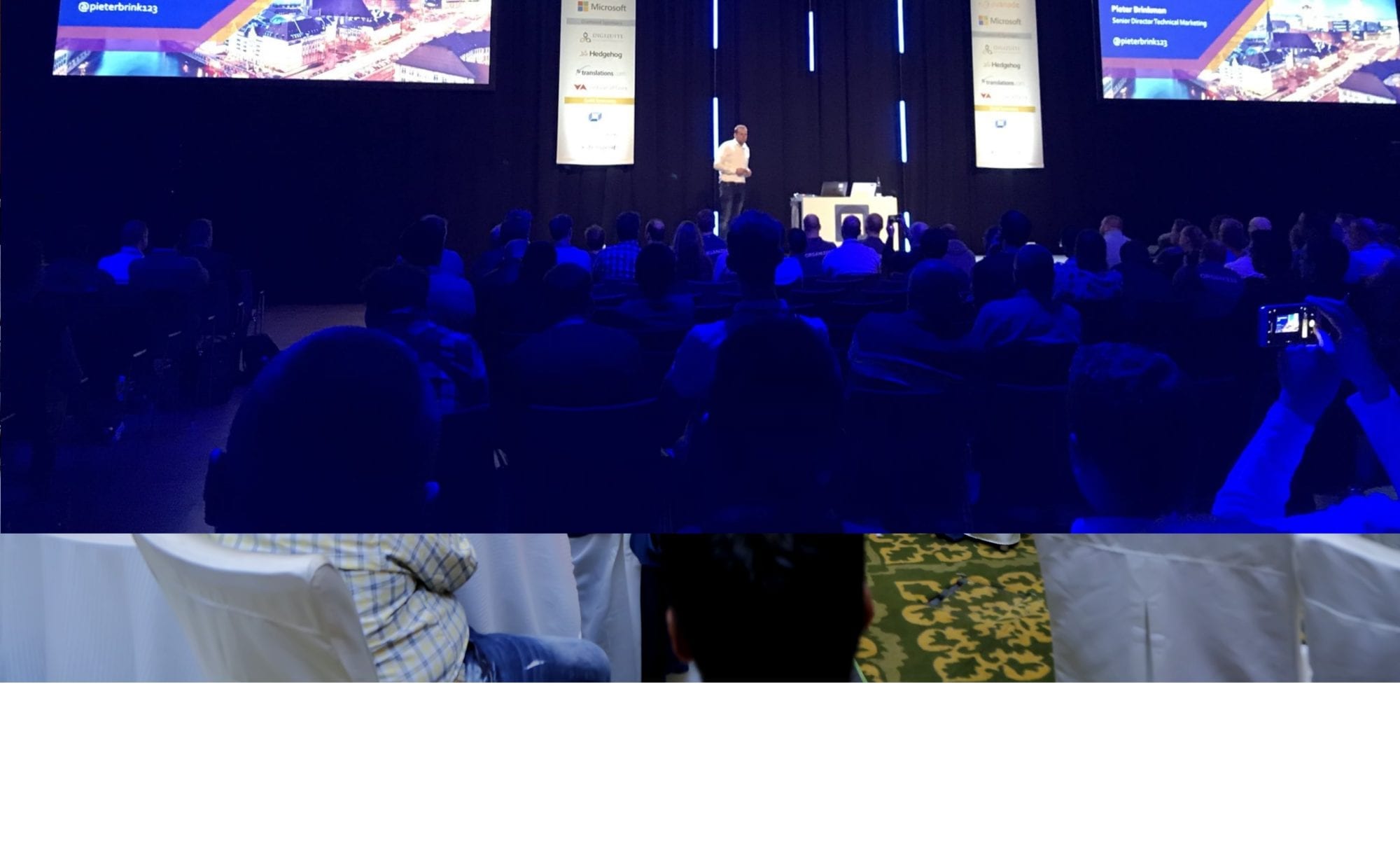During Sitecore Symposium I presented the Overview of 9.1 together with Mark Groves, Senior Director Product Management. This blogpost will cover the highlights of Sitecore 9.1 Experience Management (XM).
As addressed in the first blogpost of the What’s new in Sitecore 9.1 series, Sitecore 9.1 has a lot of exciting innovation and value that will help our customers get to market faster, and ongoing refinements and enhancements to existing functionality.
The most important headlines for Sitecore 9.1 Content management are; Headless, Sitecore Experience Accelerator (SxA), platform enhancements and the new UI – Horizon.
Headless
The headless CMS concept is born out of the demands from the businesses that has an increased focus on engaging customers with personalized content via multiple channels at all stages of the customer journey. The content in a headless CMS is considered “pure”, because it has no presentation layer attached, and content can be reused for display on any device; website, mobile, tablet, Internet of Things devices, smart watches, etc.
Headless has been a ‘buzz word’ for a while now and with the 9.1 release we are introducing Sitecore JavaScript Services (JSS) to the general public after a very successful preview program where we had 4 releases and got a lot of valuable feedback from our community.
JSS provides a native developer experience to consume Sitecore content for those working in the extremely popular React, Angular, and View frameworks.
What exactly do we mean at Sitecore when we talk about Headless?
Well, we can say Sitecore was the first in market, and has the longest history and experience when it comes to “headless”.
In essence, a headless CMS has no part in delivering the content, it is purely concerned with entering and storing content, usually in form-like interfaces with content stored in a database.
Front end developers then request the pure content (and metadata) controlling the presentation experience to the visitors, meaning marketers are more concerned with the content produced not how it looks.
In turn, personalization is either controlled by the developer or by an additional third-party system which needs to be integrated, managed and reported on separately from the content serving it
What we are seeing from analysts and partners is that various content-centric scenarios require differing approaches to how you architect and deploy websites or applications.
Sitecore has always had a strong story around multi-channel re-use of content since we are an item-based CMS with full separation of content and presentation. By enabling multiple options, we can allow marketers and developers to choose a framework most appropriate to the task and the teams involved.
There are multiple ways to create headless solutions powered by SitecoreSitecore Services Client Web API, Sitecore Experience Accelerator to model the data output these front-end developers might want in a JSON output, and now Sitecore JavaScript Services.
What is Sitecore JSS?
Sitecore Javascript Services
JSS is a complete SDK for JavaScript developers allowing to build full-fledged modern solutions using Sitecore and JavaScript and being completely disconnected during development and deploy to any platform in a headless configuration with full Experience Platform capability preserved.
JSS provides a toolkit for an audience traditionally not served by Sitecore; the front-end Developer. The front-end developer will be able to use whatever platform and technology they wish to be able to develop their experience (e.g. a Mac and the latest JavaScript framework). The Sitecore environment carries on existing as normal but has references to the JavaScript app (we ingest the external application) to allow for in context (WYSIWYG) editing and allowing the marketer to see what the experience will look like for the visitor. JSS will also allow the marketer to personalize the experience as they would with any other Sitecore site.
Sitecore 9.1 includes JSS server components within the platform,the front-end SDK will be released as open source and therefore available to the community in general. We will also be offering a 9.0 compatible release of JSS to go alongside the 9.1 compatible version.
Sitecore Accelerator Framework (SxA)
Another key strategy to help customers in their time to market is the Sitecore Experience Accelerator , or SXA! Since its launch more than 2 years ago, SXA has been gaining considerable traction and we continue to take on the feedback and build a comprehensive and ambitious road map for this product over the coming years.
Sitecore Experience Accelerator
The Sitecore Experience Accelerator (SXA) reduces your time to market by allowing content teams to design, assembly, and deploy web content across channels with fewer development resources.
With the 9.1 release we continue fixing issues and enhancing functionality based on feedback form our partners, customers and community. We are also adding new features and functionality.
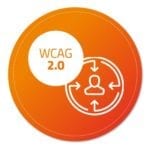 We have started on the WCAG compliance journey – something which is becoming increasingly important as some of our customers are now either obligated by law (government organizations) or simply determined to deliver websites that are Accessible to visitors with disabilities.
We have started on the WCAG compliance journey – something which is becoming increasingly important as some of our customers are now either obligated by law (government organizations) or simply determined to deliver websites that are Accessible to visitors with disabilities.
While we do not have the full control to always assert that the site is accessible, we can go a long way to making it easier to create such websites by:
- Validating that the page we generate with OOTB markup and code is accessible by users of screen readers
- Making sure that our components can be configured for people with disabilities
- Provide guidelines to experience designers and authors that they can consult in case they want to create an accessible site. e.g.:
- Always provide an “Alt text” that can be read to a user with visual impairment by screen readers)
- Provide large clickable actions for people with motor disabilities
Platform Enhancements
As mentioned earlier, we are constantly taking in feedback from our community of developers, partners and customers to ensure we are fixing the issues and enhancing the features which matter in the current platform – we have spent thousands of hours for the 9.1 release in this area!
In Sitecore 9.1 we made 3rd party updates, including; NET Framework, Newtonsoft. JSON, Telerik and Solr.Net.
Also, we implemented Content Search improvements, including; native indexing of Word and PDF files available in Azure and OnPrem, Major architecture improvement and customization simplicity and Support of Solr 7.2.1.
Architectural changes
Next to 3rd party updates and search improvements we also addressed architectural changes requested from our community:
- Added Sitecore Helix folders (Foundation, Feature, Project) to their commonly used locations in the content tree. Item ids of these folders match those commonly used in existing SXA and Habitat solutions.
- Added Sitecore Helix configuration patch folders (Foundation, Feature, Project) to App_Config\Include and configured them to load in layer-order.
- Item class now has a DescendsFrom method which allows checking whether an item inherits from a provided template id. The performance of underlying inheritance checks in the Template class has been improved.
- The ContentSearch.ComputedFields.AllTemplates computed field can now be configured to index an item’s full template inheritance tree, optionally excluding the Standard Template. A new configuration example is provided for all search providers which enables this computed field.
- Including and excluding items from a search index by template id now checks an item’s base templates as well by default. This behavior can be disabled via the checkTemplateInheritance setting in the index documentOptions.
Scalability & infrastructure improvements
- Content Delivery now does not need a Core Database connection string
- Content Delivery can now be configured without Sitecore security (membership provider)
- XM Only WDP package which contains only the Experience Management related functionality without xDB and Analytics
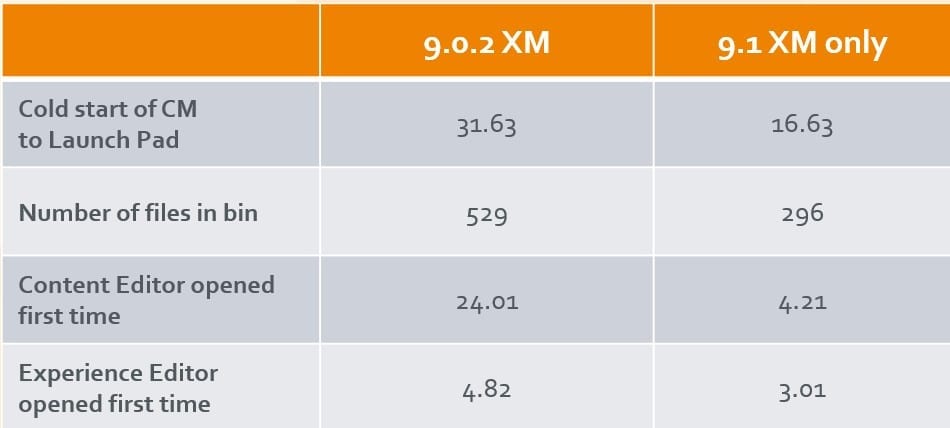 You can see the impressive numbers we have achieved so far and we’re still and improving these numbers.
You can see the impressive numbers we have achieved so far and we’re still and improving these numbers.
Performance is important to you and we take it very seriously as well!
Sitecore Forms Enhancements
In 9.0 we introduced the new Sitecore Forms and we’re delighted with the positive response we’ve had with this new module. When we launched it last year we asked for your feedback and you’ve not been shy! We’ve taken on board the comments, fixed issues and prioritised feature development for 9.1 and the future planned releases.
Specifically, for Sitecore forms enhancements in Sitecore 9.1 are conditional form elements and pre-filling of form fields.

Adding the ability to add conditions to the form elements
And the pre-filling of form fields with relevant data. It allows the users to change existing data and it also allows the pre-filling of fields to prevent users from having to re-enter data
Please note that from 9.1 WFFM is no longer available and supported for Sitecore versions 9.1+ .
Building the future
Sitecore Host is a common base for all future Sitecore NET Core instances (services/apps). It handles the aspects of a service or app that are not directly linked to functionality (e.g. logging, configuration, plugin loading etc.) and ensures that our services/apps have a uniform deployment story
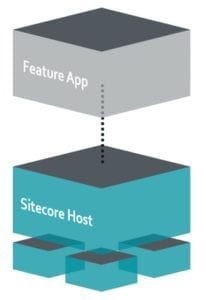
- Lean common runtime for Sitecore NET Core instances
- Can host web/console apps and windows services
- Facilitates crosscutting concerns
(e.g. logging configuration) - Functionality added via plugin mechanism
(built-in or dynamically using Nuget) - Powering Apps and Services in 9.1— Incl. Horizon, Universal Tracker and Sitecore Identity
Sitecore Identity will replace the current login screen with a Federated Authentication service and will enable SSO across XM, Commerce and Horizon. Furthermore, it will enable the use of bearer token authorization across the platform. Sitecore Identity will out of the box use Membership database as authentication source to maintain smooth upgrade story.
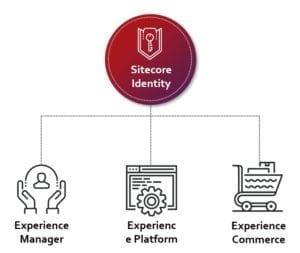
- Responsible for handling the authentication of users
- Provides Single Sign On using standard federated authentication protocols
- Based on Identity Server4
- Compatible with old Membership
- Already used as the authentication mechanism for Commerce
- From 9.1 it is the default login mechanism across the platform
Learn more about Sitecore 9.1
Next to all the new features and enhancement in Sitecore Experience Management we also added features to Sitecore Experience Platform. Read more about the new Horizon UI and all the marketing enhancements in the next posts within the What’s new in Sitecore 9.1 Series.
The full slide deck is available for you to view on SlideShare.
